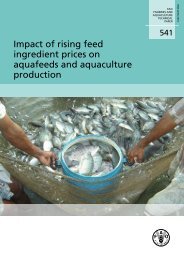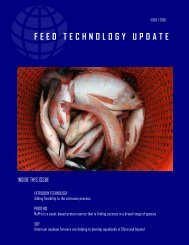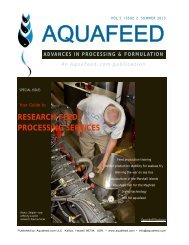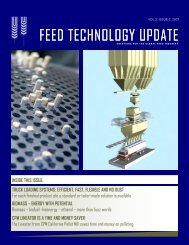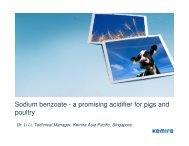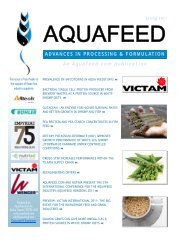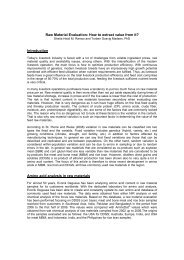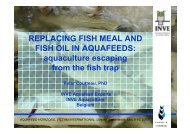FEED TECHNOLOGY UPDATE - AquaFeed.com
FEED TECHNOLOGY UPDATE - AquaFeed.com
FEED TECHNOLOGY UPDATE - AquaFeed.com
Create successful ePaper yourself
Turn your PDF publications into a flip-book with our unique Google optimized e-Paper software.
CASE STUDY<br />
production. The machine does the same<br />
thing every day. The feed looks the same<br />
every day. The quality remains the same<br />
and everything is consistent.”<br />
“During a typical week, we’ll start up on<br />
Monday morning,” Robertson said. “After<br />
we’ve loaded three or four trucks, we’ll run<br />
non-stop until sometime late Saturday night<br />
or Sunday morning when we fill up again.<br />
Then, we’ll start it all over again the next<br />
week.”<br />
“In years past,” he continued, “we never<br />
would be full and we’d start out in the hole.<br />
Usually by Wednesday or Thursday we’d<br />
have to have trucks <strong>com</strong>e in and bring us<br />
feed, sometimes eight or ten trucks a day<br />
to meet the demand because we couldn’t<br />
manufacture enough. Now, we’ve increased<br />
production enough to where we don’t have<br />
to bring in extra feed. I think we may have<br />
brought in about four loads last year.”<br />
“Overall,” Robertson said, “considering our<br />
lower maintenance, reduced downtime, increased<br />
production, and better quality feed,<br />
I would say that changing to the Conforma<br />
Clad screws and liners has resulted in an<br />
economic gain somewhere in the range of<br />
$75 to $100 thousand per year — and that<br />
would be a conservative figure.”<br />
CLADDING SPECIFICATIONS<br />
Based upon more than 20 years of research,<br />
Conforma Clad has developed three<br />
standard tungsten carbide cladding formulas:<br />
WC200; WC210; and WC219. Each formula<br />
provides superior wear protection<br />
within a wide range of operating and wear<br />
conditions, which may include abrasion,<br />
erosion, corrosion, and impact--individually<br />
or in <strong>com</strong>bination. Custom formulations also<br />
can be developed to fit specific customer<br />
requirements.<br />
Standard cladding thickness can range from<br />
0.010 to 0.065 inches (0.100 inches for<br />
simple shapes). Most cladding is applied by<br />
hand. In cases where there is not sufficient<br />
Steps in the Conforma Clad<br />
Process<br />
Step 1 – Powder Mixing<br />
The Conforma Clad process begins by<br />
mixing powdered tungsten carbide and<br />
other metals with organic binders<br />
according to specific cladding formulas.<br />
Step 2 – Cloth Formation<br />
The materials are rolled to a predetermined<br />
thickness and density, forming<br />
a flexible cloth that maintains a<br />
uniform weight and readily conforms to<br />
<strong>com</strong>plex geometries.<br />
Step 3 – Cloth Application<br />
The cloth is then cut to shape and<br />
applied.<br />
Step 4 – Furnace Brazing<br />
The clad <strong>com</strong>ponent is placed in a<br />
furnace and heated above the melting<br />
point of the hardfacing alloy. The molten<br />
alloy wicks down into the layer of<br />
tungsten carbide particles, metallurgically<br />
bonding the hard particles to the<br />
<strong>com</strong>ponent and forming the Conforma<br />
Clad cladding. When brazing is <strong>com</strong>plete,<br />
the <strong>com</strong>ponents are finished to customer<br />
specifications.<br />
hand access, mechanical aids may be employed.<br />
Inside diameters as small as 0.250<br />
inches and 6 inches long have been clad<br />
with the aid of an application rod. Chamfers<br />
and radii as small as 0.125 inches can be<br />
clad.<br />
For more information contact:<br />
Conforma Clad, Inc.:<br />
info@conformaclad.<strong>com</strong><br />
www.conformaclad.<strong>com</strong><br />
• <strong>FEED</strong> <strong>TECHNOLOGY</strong> <strong>UPDATE</strong> — June/July 2006 •



